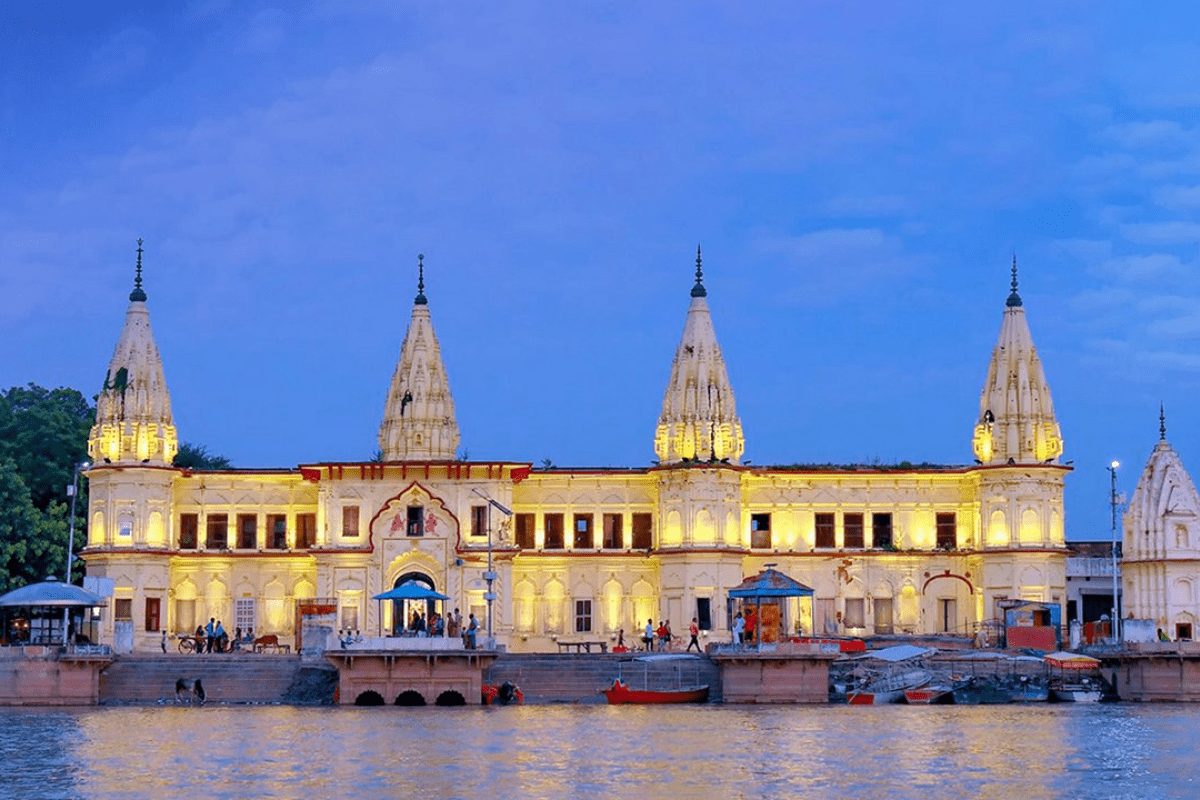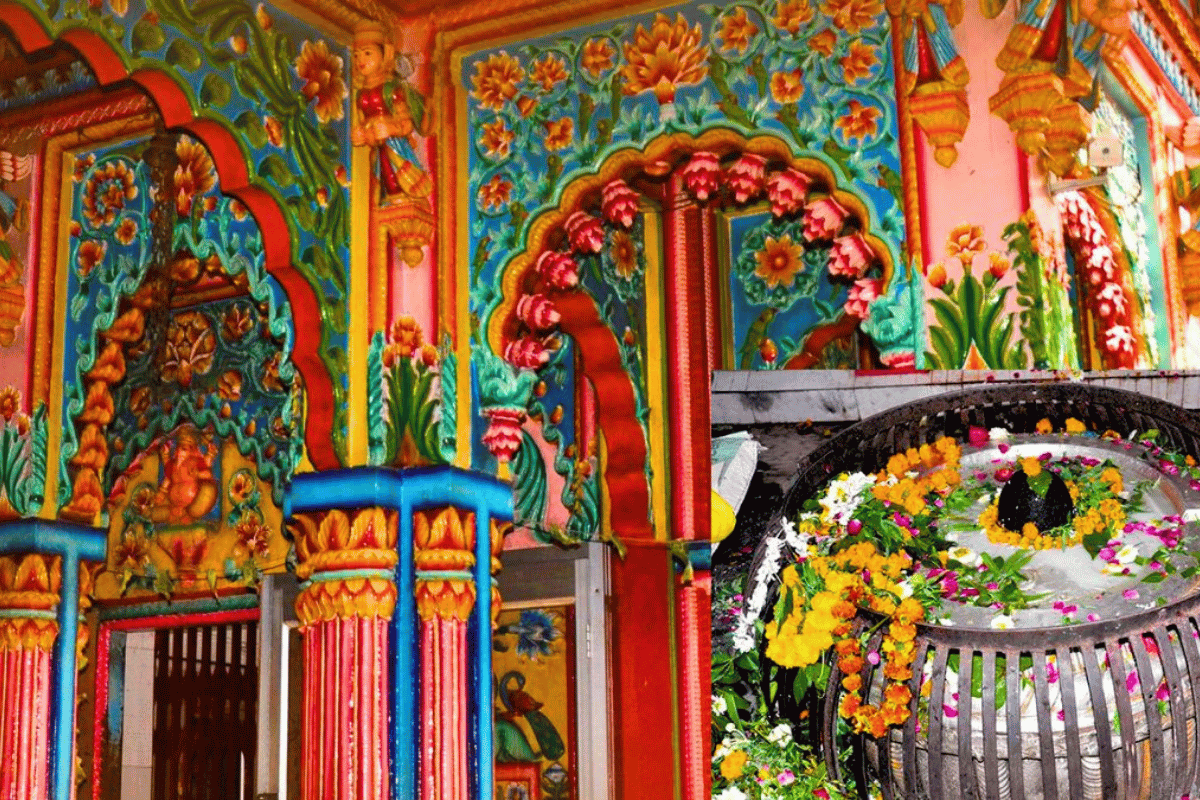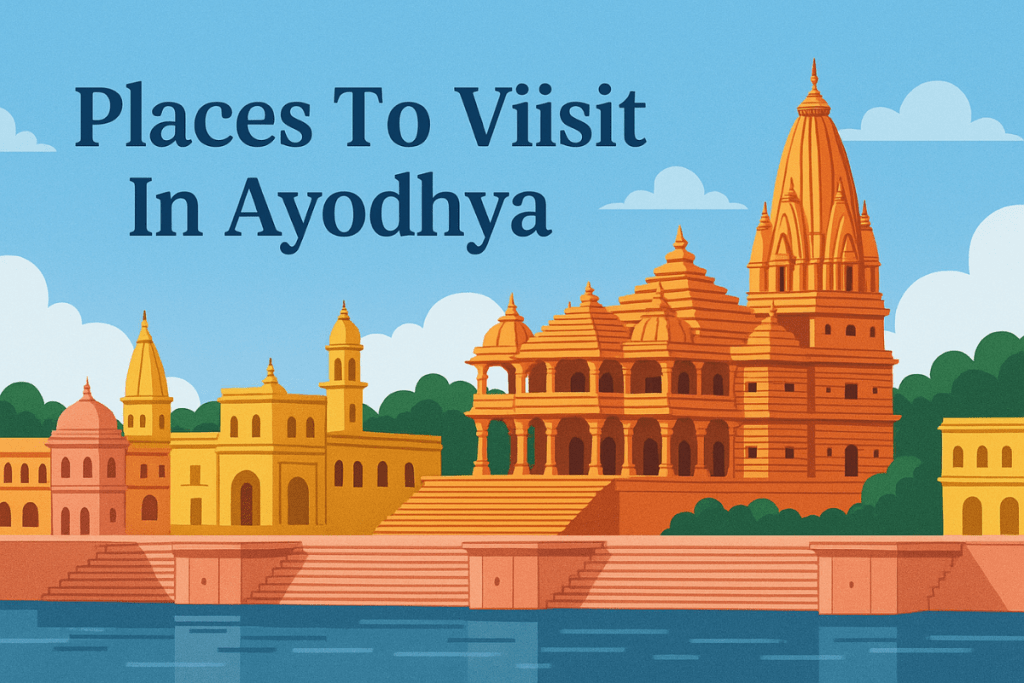A trip to Ayodhya must include visits to the famous and immensely sacred Hanuman Garhi Mandir, Ram Janmabhoomi Mandir, Kanak Bhawan, Ram ki Paidi, and the Saryu River. But after seeing all these places in Ayodhya on day one, where else can you go? If you’re planning on staying a bit longer, Ayodhya has much more to offer to tourists and devotees.
Apart from the city’s main attractions, here are some of the most well-known and popular places you can visit in Ayodhya:
1. Guptar Ghat

Approximately 10 km from Ayodhya Junction, Guptar Ghat is located at Faizabad Cantt on the banks of the Saryu river. Devotees believe that taking a bath in the holy water of this river will wash away their sins. The Sita-Ram Temple, the Chakrahari and the Guptahari shrines, and the Narasingh Temple are located atop these ghats.
2. Nageshwarnath Temple

Legend says that Lord Rama’s son, Kush, once lost his armlet in the Saryu river while bathing. A Nag-Kanya found the armlet and returned it to him. Touched by her devotion, Kush built a temple to honor her. The temple was later rebuilt in 1750. Mahashivratri is celebrated on a grand scale at this temple.
3. Lata Mangeshkar Chowk

Lata Mangeshkar Chowk is built to honor the legendary singer Lata Mangeshkar. At its heart is a 40 ft long bronze Veena sculpture that was hand-carved by renowned sculptor Ram Sutar. This Chowk has become a popular selfie spot with the locals as well as tourists.
4. Dashrath Mahal
Located 210 meters away from Hanuman Garhi Mandir (in the opposite direction from Tulsi Smarak Bhavan) is Dashrath Mahal. It is believed to be where Lord Rama’s father, Dashrath, lived. This Mahal is not as large as the original palace would have been. Nevertheless, this site allows you to experience the childhood memories of Lord Rama.
5. Choti Devkali Mandir
After she married Lord Rama, Sita Maa brought an idol of Girija Devi with her from Janakpur. It is said that King Dashrath built a temple for her to place the idol in. This temple was destroyed twice during the Mughal and Hun invasions. Later, the Mahant of the Bindu sect built a simple building to house the idol.
6. Shree Ajitnath Shwetambar Jain Temple
This Jain Mandir features carvings and murals of stories from Jain mythology. It is an important place of pilgrimage in Jainism and marks the 19 kalyankas of five Jain tirthankaras. The Dharamshala next to the Mandir offers both AC and non-AC rooms with Bhojanshala.
7. Treta Ke Thakur
Treta ke Thakur refers to Rama as the Lord of the Treta Yuga, believed to be the second age in Hinduism and the one in which Lord Rama reigned. This temple is located on the banks of the Saryu river where Rama performed the Ashwamedha Yajna. It is only open on one day of the year: on Kartik Shukla Ekadashi.
8. Ammaji Mandir
Ammaji Mandir is one of the 108 Divya Desams of Lord Vishnu. It offers incredible architectural and scenic beauty. Every year, Rama Navami is celebrated in a grand and spectacular manner here.
9. Sri Maniram Das Chavani
Sri Maniram Das Chavani is one of the most important sites in Ayodhya. Various temples, including the famous Ram Darbar, are located inside the Chavani. There are two main structures: an older building and a newer one called the Valmiki Bhavan.
Highlights include idols of Ram, Sita, and Lakshman, and the Maharshi Valmiki Shodh Samsthan, which houses a collection of rare Sanskrit books.
10. Valmiki Bhawan (Chhoti Chhawni)
The Vallmiki Bhawan is named after Valmiki, the sage who wrote the Ramayana. The white marble walls of this building are carved with the entirety of the Valmiki Ramayana. Prayers and devotional programs are held here regularly.
11. Tulsi Smarak Bhawan Museum
This museum is located 650 meters away from Shri Hanuman Garhi Mandir. It is named in memory of the poet Tulsidas, as it is believed that he composed the Ramcharitmanas here. This museum displays a collection of his writings. Religious prayer gatheings and lectures are also regularly conducted here.
At Ayodhya Astro, we help devotees attain spirituality, peace, and prosperity through worship. Our pandits perform all rituals and pujas in the temples of Ayodhya. Through us, you can worship Lord Rama in Ayodhya from anywhere in the world.
Frequently Asked Questions:
The Ram Leela performance at the Tulsi Smarak Bhavan is performed every day of the year from 6 to 9 PM.
The Treta ka Thakur temple is open only for 24 hours in a year, on the day of Kartik Shukla Ekadashi.
When visiting Ayodhya, we recommend visiting the Hanuman Garhi Mandir first. Devotees believe that seeking permission from Lord Hanuman first protects you throughout your journey.
Street food items like Gabbar Pakode, samosas, chaat, litti chokha, and bedai poori with aloo sabzi are popular in Ayodhya. Kesar milk, ladoos, malpua, khurchan peda, and dahi jalebi are also popular.
Apart from food items, you can buy religious items like idols, artifacts, sandalwood, copper, brass, and wooden artifacts in Ayodhya.



